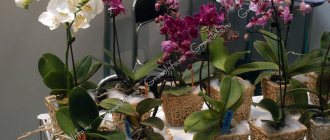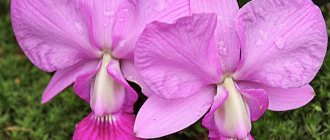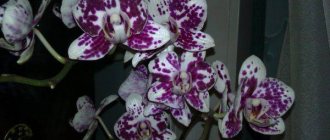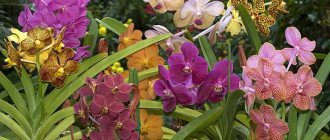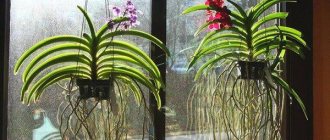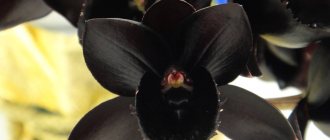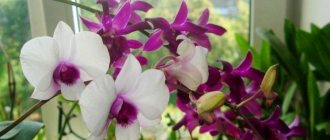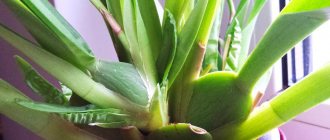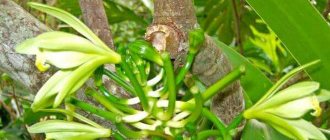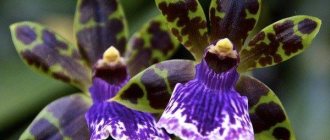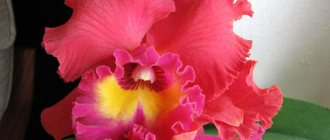Possible colors
In nature, there are 30 thousand colors of orchids. They come in one-color, two-color, with patterns, all the colors of the rainbow. However, scientists do not stop at this and continue to develop new varieties of phalaenopsis.
In room conditions
At home, all colors of orchids are found. Plants are:
- white;
- light pink;
- purple;
- blue;
- black;
- red;
- radiant;
- pistachio;
- Crayola;
- raspberry;
- burgundy;
- orange.
Hybrids and natural varieties of phalaenopsis take root in indoor conditions.
In the natural environment
Thanks to natural pollination, orchid flowers can be unpredictable in natural conditions. Of course, you won’t be able to find a black or bright blue flower. This is the work of scientists. In nature there are the following shades:
- white;
- pink;
- purple;
- yellow;
- orange;
- light pink;
- peach;
- light purple;
- pistachio
After spontaneous crossing, two-colored petals with a pattern are obtained. Such phalaenopsis are more often found in the wild.
Artificially bred varieties
The variety of orchids is enormous. Below are the most unusual and beautiful hybrid species:
- Wanda Rothschld;
- Cymbidium swordifolium;
- Cattleya Ekland;
- Miltonia flava;
- Phalaenopsis Sander;
- Dendrobium Mix;
- Royal Blue;
- Blue Mystick;
- Cymbidium Black Ruby;
- Phalaenopsis Black Butterfly.
All these varieties have unusual shades that are not found in natural conditions. Blue and black colors do not exist because the plant lacks the pigment to produce such blooms.
Modern scientists have been able to develop such varieties, but after the first flowering the flowers lose their unusual color and become a different color, usually white.
Important! Japanese scientists were able to breed a blue orchid, but it is not yet commercially available.
Pests and diseases
There are two diseases that orchids most often contract.:
- Fusarium is a dangerous fungal disease that affects the roots and then spreads further. It manifests itself in the form of rot; the affected bushes cannot be cured. The main reason is excess moisture.
- Urticaria - usually occurs at low temperatures or high humidity. Spots that look like dents appear on the leaves. Maintaining optimal conditions will help get rid of this.
Other troubles that a home orchid may encounter include insects:
- Spider mites cause silvery webbing on foliage. It appears only at low air humidity. Treatment with a soap solution helps get rid of the pest.
- Thrips form brown spots on leaves and flowers. They can only be driven away with the help of insecticides.
- Mealybug causes leaves to turn yellow and fall off; a solution of laundry soap is an effective remedy against it.
White orchids are not very capricious flowers, but for flowering and growth it is important to provide them with a favorable environment, periodically water them, saturate them with useful elements and be attentive to any changes on the foliage and roots in order to take the necessary measures in time.
Fungal
A common fungal disease is fusarium spot , caused by the Fusarium fungus: dirty gray spots appear on the leaves, which can be easily washed off by hand. The diseased plant is isolated and the conditions are improved, and if necessary, treated with a fungicide.
Bacterial
Bacterial wet rot is caused by bacteria of the genus Pseudomonas . In this case, transparent or yellowish spots appear on the leaves, which over time take on the appearance of mush.
The affected parts of the plant are removed, the cut areas are disinfected with iodine or brilliant green, and in case of severe infection, they are treated with Bordeaux mixture.
Viral
Diseases caused by viruses in orchids are difficult to identify - this can only be done in the laboratory . The diseased plant is thrown away or optimal conditions are created to boost immunity.
Unusual colors
In nature, orchids have different shades and colors. Many plants are painted in 2-3 colors at the same time. This occurs as a result of crossing.
Blue, black and cyan pigmentation in nature
Blue and black pigmentation of petals does not occur naturally. They are bred by scientists in laboratory conditions. Such a plant is able to maintain its color during just 1 flowering, which lasts 8-12 months. New flower stalks will have a different color.
Mini and midi
- The mini is a smaller version of the full-size phalaenopsis orchid. The plant differs only in small leaves and fewer buds on the peduncle.
- Midi is something between a mini and a standard orchid. For example, if a mini has leaves up to 9 cm in size, then a midi has about 16 cm, while a full-size specimen has about 20 cm.
Caring for phalaenopsis at home
Phalaenopsis are considered the most unpretentious of orchids, however, there are many nuances in their cultivation.
Priming
This is where novice gardeners usually get their first surprise: phalaenopsis should never be planted in ordinary soil! In nature, they do not encounter it, since they live in trees (some species live on rocks). Therefore, the substrate for them must be special.
The simplest option is finely chopped pine bark. Larch is even better - it is more durable. But such a substrate dries out very quickly, so it is recommended to add sphagnum moss to it in a 1:1 ratio - it retains water for a long time, and also has bactericidal properties and protects the roots from rotting.
Bark and moss can be purchased at the store. Or collect it in the forest, but in this case all the ingredients need to be boiled, because they may contain pests and pathogens.
There is another option for planting - on a piece of bark (this, of course, also needs to be boiled). In this case, the phalaenopsis is attached to the bark with wire, and the roots are wrapped in moss. Or they don’t wrap it, but in this case the orchid will have to be sprayed several times a day.
Temperature
Ideal temperature for growing phalaenopsis (2):
- during the day – 23 – 29 °C;
- at night – 18 °C.
That is, ordinary room temperature is quite suitable for him. For good growth. But not for flowering - for phalaenopsis to bloom, you need to keep it in cool conditions for at least 2 weeks, with a temperature of 13 - 15 ° C. Such conditions occur on a glazed balcony in September - send an orchid there for a couple of weeks and it will produce flower shoots.
But during flowering the temperature should be consistently warm, around 25 °C. If there are sudden changes, the phalaenopsis will drop its buds.
Lighting
Since in nature orchids are found in the eternal penumbra of huge trees, but at the same time in fairly sunny subtropics, the window sill should be light, but without direct sunlight, which can burn delicate plants. Moreover, orchids are one of those flowers that get used to their place and do not tolerate moving or even moving to another window sill quite well.
Humidity
Tropical forests have the same humidity almost all year round - 100%. In city apartments, especially in the cold season, when the heating is turned on, it barely reaches 25%. This is not enough, so phalaenopsis need to be sprayed often, but this must be done in the morning so that the leaves dry out by night. Or place trays of water nearby.
But you need to skillfully moisten the substrate: between waterings it must dry completely (2). Under no circumstances should the roots be constantly exposed to dampness - they will rot. Therefore, after watering, the water must be drained from the pan.
Fertilizers
For phalaenopsis, it is best to use special fertilizers for orchids - they are sold in stores.
Feeding
During the period of active growth, usually from April to September, phalaenopsis needs to be fed every 2 weeks. In warm weather - in the doses indicated in the instructions. But if the room is cool and it’s cloudy outside, then the norm should be halved (2).
Secret technique
There is information that efforts to breed the Blue Phalaenopsis orchid through genetic modification have been successful at a university in Japan. The gene from an Asian flower was inserted into the plant. But this was just a scientific experiment, so the genetically modified plant is unlikely to be commercially available.
The blue dye needed to color an orchid is not available to home gardeners. In addition, growers who have colored orchids do not want to share their technique with us: they want to keep it a secret. Well, okay, isn’t it surprising to have a beautiful white indoor plant, so pure and, most importantly, natural? And if you need a blue one, you can go and buy another one.
Varieties of orchids: photos with names
Orchid Buddha
In the photo there is an orchid "Buddha"
Orchid "Balm"
a cheerful beauty with a pronounced citrus aroma
Orchid "Phantom"
This species has no leaves. The flower seems to be suspended in the air. Hence its second name – “Ghost”.
READ 10 types of orchids that are striking in their beauty: recommendations for care and cultivation
This species received its name due to the structural features and location of its growth. In the tropics, in swampy areas, you can find a white flower “floating” in the air. The Linden orchid performs this trick thanks to its system of structure and life activity, namely: the open root system is attached to another vertical plant, often a tree, as a support. Then it produces its long, thin peduncles, on which the miracle of flowering occurs. This way it looks like a white bud hanging in the air.
Orchid "Monza"
The aroma is as delicate as the transparent pink-yellow petals
Photo orchid "Panda"
in the description of the variety you will definitely see a paragraph about buds with dark, chaotic inclusions - these are their distinctive features
Panda Orchid
"Ferrara ferrara"
with luxurious yellow flowers
Orchid Ferrara
Orchid "Andorra"
Andorra
Orchid "Malmo"
has a pleasant, unobtrusive smell, photo attached
Malmo
Phalaenopsis variety "Cherry Bomb"
has a tart aroma that reveals itself under the sun's rays
Cherry Bomb
Orchid "Pandora"
Pandora Orchid
Orchid "Kansas City"
close-up photo of flowers
Orchid "Kansas City"
Phalaenopsis "Golden Buddha"
exudes a subtle spicy aroma
Phalaenopsis "Golden Buddha"
Orchid "Octopus"
Orchid Octopus
Orchid "Darwin"
blooms with gorgeous flowers in pastel shades.
Orchid Darwin
Pictured is the Pavarotti orchid
Petals of dark cherry color do not fade in the sun
Orchid Pavarotti
Orchid "Phoenix"
Phoenix Orchid
Transplanting phalaenopsis at home
Phalaenopsis grow aerial roots directly on top of the pot, so the size of the container is not important to them. These orchids are replanted when the substrate begins to decompose - if, when watering, small particles of bark begin to wash out of the drainage holes, then it’s time. As a rule, this happens after 2 - 3 years.
It is better to replant in the spring after the phalaenopsis has flowered. The substrate must be taken completely new, the old one cannot be used (diseases can lurk in it).
Thoroughly clean the roots from soil residues, inspect them thoroughly, remove damaged ones (dark, dried, rotten, yellowed). Treat the cuts with crushed coal.
Place the orchid in a pot (you can use an old one, but it needs to be disinfected), straighten the roots and carefully fill all the voids with substrate, but not tightly so that the roots can breathe.
